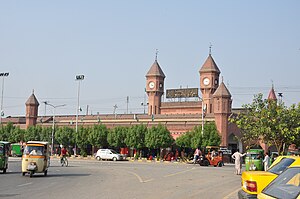Lahore Junction Railway Station لاہور جنکشن ریلوے اسٹیشن | ||||||||||||||||
|---|---|---|---|---|---|---|---|---|---|---|---|---|---|---|---|---|
 Lahore Junction Station Entrance | ||||||||||||||||
| General information | ||||||||||||||||
| Location | Empress Road (Shahrah-e-Abdul Hameed bin Badees) Lahore-54000 Pakistan | |||||||||||||||
| Coordinates | 31°34′38″N 74°20′11″E / 31.5772°N 74.3363°E | |||||||||||||||
| Owned by | Ministry of Railways | |||||||||||||||
| Line(s) | ||||||||||||||||
| Platforms | 11 | |||||||||||||||
| Connections | ||||||||||||||||
| Construction | ||||||||||||||||
| Structure type | Standard (on ground station) | |||||||||||||||
| Platform levels | 2 | |||||||||||||||
| Parking | ||||||||||||||||
| Bicycle facilities | Available | |||||||||||||||
| Accessible | ||||||||||||||||
| Other information | ||||||||||||||||
| Status | Functional | |||||||||||||||
| Station code | LHR | |||||||||||||||
| Fare zone | Pakistan Railways Lahore Zone | |||||||||||||||
| History | ||||||||||||||||
| Opened | 1860 | |||||||||||||||
| Electrified | Yes | |||||||||||||||
| Previous names | Guru Amar Das Railway Station | |||||||||||||||
| Services | ||||||||||||||||
| ||||||||||||||||
| ||||||||||||||||
Lahore Junction Railway Station (Urdu, Punjabi: لاہور جنکشن ریلوے اسٹیشن), is the main railway station in Lahore, Pakistan. It is among the oldest railway stations of the Indian subcontinent. Construction commenced shortly after the 1857 War of Independence.[1] It was built in the style of a medieval fort with thick walls, turrets, and holes to direct gun and cannon fire for the defence of the structure.[2]
It is located at the junction between Circular Road and Allama Iqbal Road and bounded on the north side by the old Grand Trunk Road. The station is now owned by Pakistan Railways, and also serves as its headquarters.
- ^ "Scinde, Punjaub & Delhi Railway - FIBIwiki". wiki.fibis.org. Retrieved 8 May 2021.
- ^ Glover, William (January 2007). Making Lahore Modern, Constructing and Imagining a Colonial City. Univ of Minnesota Press. ISBN 978-0-8166-5022-4.
The Lahore station, built during a time when securing British civilians and troops against a future "native" uprising was foremost in the government's mind, fortified medieval castle, complete with turrets and crenellated towers, battered flanking walls, and loopholes for directing rifle and cannon fire along the main avenues of approach from the city


